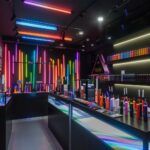Toilet cubicle manufacturers play a pivotal role in designing restrooms that are functional, stylish, and built to last. From corporate offices and educational institutions to public facilities and high-traffic areas, a well-made toilet cubicle can greatly improve a restroom’s comfort, privacy, and aesthetic appeal. This guide delves into everything Toilet Cubicle Manufacturers need to know, from selecting materials to understanding industry trends, to creating durable, high-quality cubicles that meet the needs of diverse spaces.
Why Quality Toilet Cubicles Matter
Toilet cubicles might seem like a simple necessity, but their quality has a profound impact on the restroom environment. High-quality cubicles:
Enhance Privacy: Proper design and durable materials ensure users feel secure, a key component of restroom comfort.
Promote Hygiene: Water-resistant and easy-to-clean surfaces contribute to a cleaner restroom environment, an essential factor in high-traffic areas.
Withstand Heavy Use: In busy spaces, cubicles must be robust enough to handle continuous usage without frequent maintenance.
Elevate Aesthetic Appeal: A well-designed cubicle can add sophistication and elegance, creating a positive impression for businesses and public spaces alike.
Key Materials in Toilet Cubicle Manufacturing
Selecting the right material for toilet cubicles is crucial for durability, maintenance, and aesthetics. Here’s an overview of the materials commonly used by leading manufacturers:
High-Pressure Laminate (HPL): Known for its moisture resistance and durability, HPL is a versatile choice for various settings. Available in multiple colors and finishes, it can be tailored to match any decor.
Compact Laminate (Solid Core Laminate): Compact laminate is especially resilient, making it ideal for humid environments like gyms and pools. It is solid throughout, providing extra durability.
Stainless Steel: For premium spaces, stainless steel offers a sleek, modern look that’s resistant to rust and easy to clean. It is often used in corporate and high-end restrooms for its upscale appearance.
Solid Plastic (HDPE): High-density polyethylene is a popular choice for public spaces, as it resists moisture, bacteria, and vandalism. It’s commonly used in schools, parks, and public restrooms.
Tempered or Frosted Glass: While less common, glass cubicles are often chosen for their aesthetic appeal and are used in upscale establishments. The material adds a modern touch and is easy to maintain.
Essential Design Features for Modern Toilet Cubicles
As restroom design evolves, so do user expectations for functionality and comfort. The following features are trending in modern toilet cubicles:
Full-Height Cubicles: Full-height designs provide added privacy by eliminating gaps at the floor and ceiling, making them ideal for corporate and public restrooms.
Seamless Edges and Concealed Hardware: Sleek, seamless designs and hidden hardware contribute to a more refined appearance and improve hygiene by reducing spaces where dirt can accumulate.
Accessibility: ADA-compliant cubicles with wider doors and grab bars are essential for inclusivity. They ensure that restroom facilities are accessible to all, regardless of mobility.
Soundproofing: In locations where privacy is a top priority, soundproof cubicles enhance comfort and reduce noise, making them a popular choice for office buildings.
Customizable Aesthetics: Offering various colors, textures, and finishes allows businesses to match their restroom cubicles with their brand or interior design. Customization has become a key factor for establishments seeking to create a cohesive look.
Industry Trends in Toilet Cubicle Manufacturing
As the demands of commercial and public restroom users evolve, manufacturers are adopting new trends to meet those expectations. Here are some of the latest trends shaping the industry:
Eco-Friendly Materials and Processes: Many manufacturers now offer products made from recycled or sustainable materials. This includes low-VOC (Volatile Organic Compounds) laminates and recycled metals, which appeal to eco-conscious clients.
Hygiene-Enhancing Features: Since the pandemic, there has been a heightened focus on hygiene. Manufacturers are incorporating antimicrobial surfaces and easy-to-clean materials that reduce bacterial growth.
Smart Technology Integration: Smart cubicles with occupancy sensors, touchless doors, and usage-tracking sensors are becoming popular, particularly in smart building applications. These features streamline maintenance and improve user convenience.
Biophilic Design Elements: Incorporating natural finishes and textures is trending in restroom design. By using materials that mimic wood or stone, manufacturers can help create a calming, nature-inspired atmosphere.
Best Practices for Toilet Cubicle Manufacturers
In a competitive market, the following best practices can help manufacturers stand out and provide high-quality products that meet client needs:
Focus on Durability: Using high-quality materials and ensuring solid construction allows cubicles to withstand heavy use, especially in public restrooms.
Prioritize Customization: Offering a wide range of colors, materials, and finishes can help clients achieve a customized look that aligns with their brand.
Stay Updated on Regulations: Manufacturers should stay current with ADA and other accessibility standards to ensure their products are compliant and suitable for all users.
Embrace Sustainable Practices: Adopting eco-friendly materials and low-waste manufacturing processes can set a company apart in the eyes of environmentally conscious clients.
Provide Excellent After-Sales Support: Offering installation guidance, maintenance tips, and responsive customer service helps clients get the most value from their cubicles, encouraging loyalty and positive reviews.
The Future of Toilet Cubicle Manufacturing
As the industry continues to evolve, toilet cubicle manufacturers are likely to see even more emphasis on:
Sustainability: With more clients seeking eco-friendly solutions, sustainable materials and manufacturing processes are expected to become industry standards.
Advanced Hygiene Features: Touchless technology and antimicrobial materials will continue to grow in popularity, especially in high-traffic public spaces.
Smart Restrooms: As IoT (Internet of Things) technology advances, restrooms may feature more sensors and automation, helping with everything from occupancy tracking to self-cleaning surfaces.
User Comfort and Privacy: Manufacturers are likely to prioritize user-centered designs, enhancing comfort, soundproofing, and full-height options to improve the restroom experience.
Conclusion
For toilet cubicle manufacturers, staying ahead in a competitive market means focusing on quality, innovation, and customer satisfaction. By choosing durable materials, offering customizable options, and embracing industry trends, manufacturers can create products that meet the demands of modern restrooms. Whether it’s an office, school, or public facility, a well-designed Toilet Cubicle Manufacturers In Delhi enhances the user experience and sets the standard for cleanliness, privacy, and comfort.


















